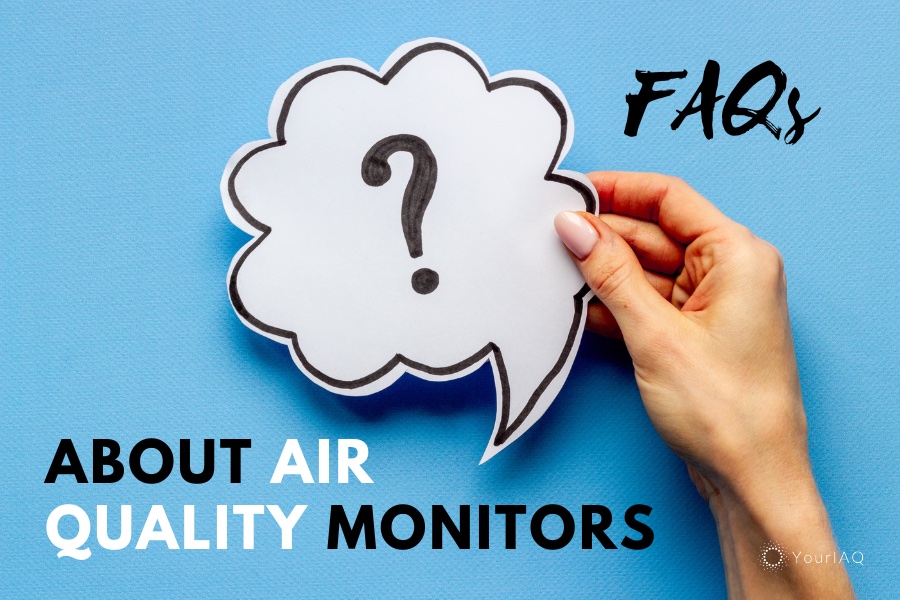
Air quality monitors are essential tools for assessing the cleanliness and safety of the air we breathe. As their popularity grows, so do the questions surrounding their functionality and accuracy. This FAQ addresses common air quality monitor questions, ensuring you have the knowledge to make informed decisions.
What is an air quality monitor?
An air quality monitor is a device that measures the amount of pollutants in the air. It can be used to measure a variety of pollutants, including particulate matter (PM), ozone (O3), radon, carbon monoxide (CO), carbon dioxide (Co2), volatile organic compounds (VOCs), and more.
Learn More:
How Is Indoor Air Quality Is Measured? What You Need to Know
What pollutants do air quality monitors measure?
The pollutants that an air quality monitor measures will depend on the type of monitor. Some monitors measure a limited number of pollutants, while others measure a wider range. The most common pollutants that air quality monitors measure are:
- Particulate matter (PM 2.5): This is a mixture of solid particles and liquid droplets suspended in the air. PM can be harmful to human health, especially when it is small enough to enter the lungs.
- Radon (O3): This is a naturally occurring radioactive gas that seeps into homes and other buildings through cracks in the foundation. Radon is the second leading cause of lung cancer in the U.S.
- Carbon monoxide (CO): This is a gas that is produced by incomplete combustion of fuels. CO can reduce the amount of oxygen that the blood can carry, leading to headaches, dizziness, and nausea.
- Volatile organic compounds (VOCs): These are gases or vapors emitted from a variety of sources, including paints, cleaning products, and furniture. VOCs can irritate the eyes, nose, and throat, and they can also worsen respiratory conditions.
An indoor air quality monitor also measures common air factors such as temperature, air pressure, and humidity. Some can even detect the presence of biological pollutants such as mold. IAQ by Sensables, for example, measures more than 20 potentially harmful airborne pollutants.
Learn more about IAQ by Sensables.
How accurate are air quality monitors?
The accuracy of an air quality monitor depends on the type of monitor and the pollutants it is measuring. Some monitors are more accurate than others. As a general rule, the more sophisticated the sensor technology, the more likely a monitor is to be accurate. But they can be expensive.
The accuracy of an air quality monitor is also affected by the environment in which it is used. For example, a monitor that is used in a dusty environment with a lot of open space will be less accurate than a monitor that is used in a clean, smaller environment.
Where can I buy an air quality monitor?
Air quality monitors can be purchased online or at home improvement stores. When choosing an air quality monitor, it is important to consider the pollutants that you want to measure, the accuracy of the monitor, and the price.
Check out IAQ by Sensables, an indoor air quality monitor you can set up in less than one minute.
How do I use an air quality monitor?
The instructions for using an air quality monitor will vary depending on the type of monitor you have. Some monitors are simple to use, while others require more complex setup and operation. It is important to read the instructions carefully before using an air quality monitor.
See also:
A Beginner’s Guide to Testing Your Home’s Air
What should I do if my air quality monitor shows high levels of pollutants?
If your air quality monitor shows a high levels of any pollutant, you should take steps to improve the air quality in your home or workplace. This may include opening windows, using an air purifier, or reducing your exposure to pollutants. Some pollutants like mold or radon may require the help of a professional.
What is the difference between an indoor and outdoor air quality monitor?
Indoor air quality monitors measure the pollutants in the air inside your home or workplace. Outdoor air quality monitors measure the pollutants in the air outside.
What are the benefits of using an air quality monitor?
There are many benefits to using an indoor air quality monitor. Air quality monitors can help you:
- Identify sources of pollution in your home or workplace.
- Track the levels of pollutants in the air.
- Take steps to improve the air quality in your home or workplace.
- Protect you and your family’s health from the effects of air pollution.







